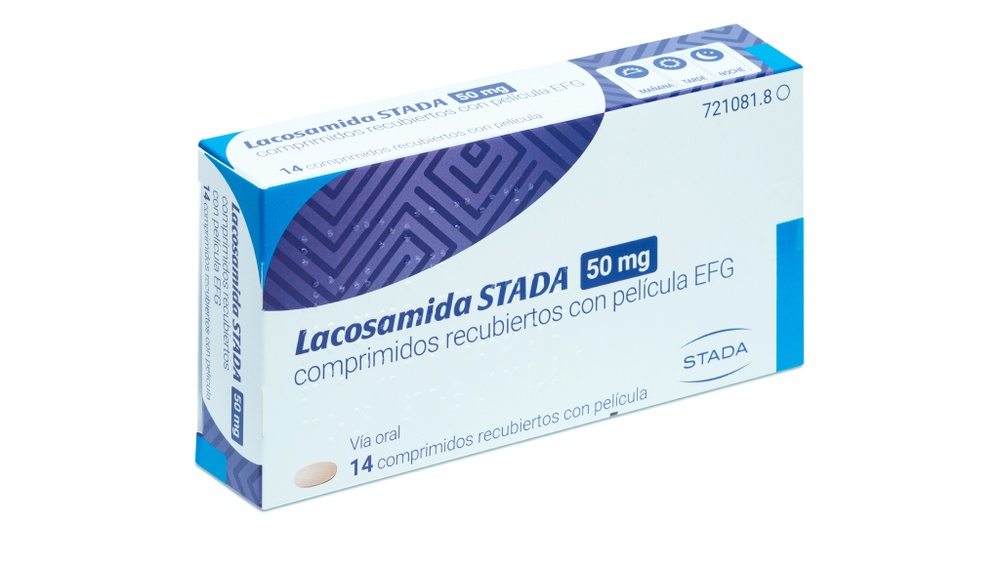

LACOSAMIDA STADA 50 mg COMPRIMIDOS REVESTIDOS POR PELÍCULA

Pergunte a um médico sobre a prescrição de LACOSAMIDA STADA 50 mg COMPRIMIDOS REVESTIDOS POR PELÍCULA

Como usar LACOSAMIDA STADA 50 mg COMPRIMIDOS REVESTIDOS POR PELÍCULA
Introdução
Prospecto: informação para o paciente
Lacosamida Stada 50 mg comprimidos revestidos com película EFG
Lacosamida Stada 100 mg comprimidos revestidos com película EFG
Lacosamida Stada 150 mg comprimidos revestidos com película EFG
Lacosamida Stada 200 mg comprimidos revestidos com película EFG
Leia todo o prospecto detenidamente antes de começar a tomar este medicamento, porque contém informações importantes para si.
- Conserva este prospecto, porque pode ter que voltar a lê-lo.
- Se tiver alguma dúvida, consulte o seu médico ou farmacêutico.
- Este medicamento foi prescrito apenas para si, e não deve dá-lo a outras pessoas, mesmo que tenham os mesmos sintomas que si, porque pode prejudicá-las.
- Se experimentar efeitos adversos, consulte o seu médico ou farmacêutico, mesmo que se trate de efeitos adversos que não aparecem neste prospecto. Ver seção 4.
Conteúdo do prospecto
- O que é Lacosamida Stada e para que é utilizado
- O que precisa saber antes de começar a tomar Lacosamida Stada
- Como tomar Lacosamida Stada
- Efeitos adversos possíveis
- Conservação de Lacosamida Stada
- Conteúdo do envase e informações adicionais
1. O que é Lacosamida Stada e para que é utilizado
O que é Lacosamida
Este medicamento contém lacosamida, que pertence a um grupo de medicamentos chamados “medicamentos antiepilépticos”. Estes medicamentos são utilizados para tratar a epilepsia.
- Foi prescrito este medicamento para reduzir o número de crises que padece.
Para que é utilizado lacosamida
Lacosamida é utilizado:
- sozinho e em associação com outros medicamentos antiepilépticos em adultos, adolescentes e crianças a partir de 2 anos, para tratar um certo tipo de epilepsia caracterizada pela aparência de “crises de início parcial com ou sem generalização secundária”. Neste tipo de epilepsia as crises afetam apenas um lado do seu cérebro. No entanto, podem então estender-se a zonas mais grandes em ambos os lados do seu cérebro.
- em associação com outros medicamentos antiepilépticos em adultos, adolescentes e crianças a partir de 4 anos para o tratamento de convulsões tónico-clônicas generalizadas primárias (convulsões graves, incluindo a perda de consciência) em pacientes com epilepsia generalizada idiopática (o tipo de epilepsia que se acredita ter uma causa genética).
2. O que precisa saber antes de começar a tomar Lacosamida Stada
Não tome Lacosamida Stada
- se é alérgico a lacosamida ou a algum dos outros componentes deste medicamento (incluídos na seção 6). Se não tem certeza se é alérgico, consulte o seu médico.
- se tem um problema do ritmo cardíaco chamado bloqueio AV de segundo ou terceiro grau.
Não tome este medicamento se algum dos acima for aplicável no seu caso. Se não tem certeza, consulte o seu médico ou farmacêutico antes de tomar este medicamento.
Advertências e precauções
Consulte o seu médico antes de começar a usar este medicamento se:
- tem pensamentos de autolesão ou suicídio. Um pequeno número de pessoas em tratamento com antiepilépticos, tais como lacosamida, tiveram pensamentos de autolesão ou suicídio. Se em algum momento tiver este tipo de pensamentos, entre em contato com o seu médico imediatamente.
- tem um problema de coração que afeta o ritmo cardíaco e, com frequência, o seu pulso é especialmente lento, rápido ou irregular (como um bloqueio AV, fibrilação auricular e flutter auricular).
- tem uma doença cardíaca grave, como insuficiência cardíaca ou teve um infarto do miocárdio.
- se mareia ou cai com frequência. Lacosamida pode produzir tontura, o que poderia aumentar o risco de lesões acidentais ou quedas. Isso significa que deve ter cuidado até que esteja acostumado aos efeitos deste medicamento.
Se algum dos acima for aplicável no seu caso (ou não tem certeza), consulte o seu médico ou farmacêutico antes de tomar este medicamento.
Se estiver tomando lacosamida e experimentar sintomas de ritmo cardíaco anormal (como ritmo cardíaco lento, rápido ou irregular, palpitações, dispneia (dificuldade para respirar), sensação de tontura, desmaio), consulte com o seu médico imediatamente (ver seção 4).
Crianças
Lacosamida não é recomendado em crianças menores de 2 anos com epilepsia caracterizada pela aparência de crises de início parcial, nem em crianças menores de 4 anos com crises tónico-clônicas generalizadas. Isso se deve ao fato de que ainda não se sabe se é eficaz e seguro para as crianças deste grupo etário.
Outros medicamentos e Lacosamida Stada
Informa ao seu médico ou farmacêutico se está tomando, tomou recentemente ou poderia ter que tomar qualquer outro medicamento.
Em particular, informa ao seu médico ou farmacêutico se está tomando algum dos seguintes medicamentos que afetam o coração, pois lacosamida pode afetar o coração.
- medicamentos para tratar problemas cardíacos.
- medicamentos que possam aumentar o “intervalo PR” em um exame do coração (ECG ou eletrocardiograma) como os medicamentos para a epilepsia ou a dor chamados carbamazepina, lamotrigina ou pregabalina.
- medicamentos usados para tratar certos tipos de arritmia ou insuficiência cardíaca.
Se algum dos acima for aplicável no seu caso (ou não tem certeza) fale com o seu médico ou farmacêutico antes de tomar este medicamento.
Informa também ao seu médico ou farmacêutico se está tomando algum dos seguintes medicamentos. O motivo é que também podem aumentar ou diminuir o efeito de lacosamida no seu organismo.
- os medicamentos para as infecções por fungos, como fluconazol, itraconazol ou cetoconazol
- um medicamento para o VIH, como ritonavir
- os medicamentos para as infecções bacterianas, como claritromicina ou rifampicina
- uma planta medicinal que se utiliza para tratar a ansiedade e a depressão leves chamada erva-de-São-João.
Se algum dos acima for aplicável no seu caso (ou não tem certeza) fale com o seu médico ou farmacêutico antes de tomar lacosamida.
Toma de Lacosamida Stada com álcool
Como medida de segurança não tome este medicamento com álcool.
Gravidez e amamentação
As mulheres em idade fértil devem falar do uso de anticoncepcionais com o médico.
Se está grávida ou em período de amamentação, acredita que possa estar grávida ou tem intenção de engravidar, consulte o seu médico ou farmacêutico antes de utilizar este medicamento.
Não se recomenda tomar lacosamida se está grávida, pois não se conhecem os efeitos deste medicamento sobre a gravidez e o feto. Não se recomenda amamentar um bebê enquanto toma lacosamida, porque lacosamida passa para o leite materno. Peça conselho imediatamente ao seu médico se está grávida ou planeia engravidar. Eles o ajudarão a decidir se deve tomar lacosamida ou não.
Não interrompa o tratamento sem falar antes com o seu médico, pois isso poderia aumentar as convulsões (crises). Um agravamento da sua doença também pode prejudicar o feto.
Condução e uso de máquinas
Não deve conduzir, andar de bicicleta ou usar qualquer ferramenta ou máquinas até que saiba se este medicamento o afeta. O motivo é que lacosamida pode produzir tontura ou visão borrada.
3. Como tomar Lacosamida Stada
Siga exatamente as instruções de administração deste medicamento indicadas pelo seu médico ou farmacêutico. Em caso de dúvida, consulte novamente o seu médico ou farmacêutico. Outra(s) forma(s) de lacosamida pode(m) ser mais adequada(s) para as crianças; consulte o seu médico ou farmacêutico.
Toma de Lacosamida
- Tome lacosamida duas vezes ao dia, com um intervalo de aproximadamente 12 horas.
- Tente tomar mais ou menos à mesma hora todos os dias.
- Tome o comprimido de lacosamida com um copo de água.
- Pode tomar lacosamida com as refeições ou por separado.
Normalmente, começará a tomar uma dose baixa todos os dias e o seu médico aumentará a dose lentamente ao longo de várias semanas. Quando atingir a dose que funciona bem no seu caso, o que se chama “dose de manutenção”, tomará a mesma quantidade todos os dias. Lacosamida é usado como tratamento a longo prazo. Deverá continuar a tomar lacosamida até que o seu médico lhe diga que o interrompa.
Que quantidade tomar
A seguir, são enumeradas as doses normais recomendadas de lacosamida para diferentes grupos etários e de peso. O seu médico poderia prescrever uma dose diferente se tiver problemas de rins ou de fígado.
Adolescentes e crianças que pesam 50 kg ou mais e adultos
Quando tome lacosamida sozinho:
A dose de início habitual é de 50 mg duas vezes ao dia.
O seu médico também pode prescrever uma dose de início de 100 mg de lacosamida duas vezes ao dia.
O seu médico pode aumentar a dose que toma duas vezes ao dia em 50 mg cada semana, até que atinja uma dose de manutenção entre 100 mg e 300 mg duas vezes ao dia.
Quando tome lacosamida com outros medicamentos antiepilépticos:
A dose de início habitual é 50 mg duas vezes ao dia.
O seu médico pode aumentar a dose que toma duas vezes ao dia em 50 mg cada semana, até que
atinja uma dose de manutenção entre 100 mg e 200 mg duas vezes ao dia.
Se pesa 50 kg ou mais, o seu médico pode começar o tratamento de lacosamida com uma única dose “de carga” de 200 mg. Então começaria a tomar a dose contínua de manutenção 12 horas mais tarde.
Crianças e adolescentes que pesam menos de 50 kg
- No tratamento das convulsões de início parcial: observe que lacosamida não é recomendada para crianças menores de 2 anos.
- No tratamento das convulsões tónico-clônicas primárias generalizadas: observe que lacosamida não é recomendada para menores de 4 anos.
A dose depende do peso corporal. Para doses abaixo de 50 mg, pode ser disponibilizado um xarope. Normalmente se começa o tratamento com o xarope e só se muda para comprimidos se o paciente é capaz de tomá-los e de obter a dose correta com comprimidos de diferentes concentrações. O médico prescreverá a forma farmacêutica que se ajuste melhor.
Se tomar mais lacosamida do que deve
Se tomou mais lacosamida do que deve, consulte o seu médico imediatamente. Não tente conduzir.
Pode experimentar:
- tontura;
- sensação de tontura (náuseas) ou tontura (vômitos);
- convulsões (crises), problemas do ritmo cardíaco como pulso lento, rápido ou irregular, coma ou queda da pressão sanguínea com taquicardia e sudorese.
Se esquecer de tomar lacosamida
- Se esqueceu de tomar uma dose nas 6 horas seguintes à dose programada, tome-a assim que se lembrar.
- Se esqueceu de tomar uma dose após as 6 horas seguintes à dose programada não tome a dose esquecida, em vez disso, tome lacosamida na próxima vez em que normalmente a tomaria.
- Não tome uma dose dupla para compensar as doses esquecidas.
Se interromper o tratamento com lacosamida
- Não deixe de tomar lacosamida sem dizer ao seu médico, pois a epilepsia pode aparecer novamente ou pode piorar.
- Se o seu médico decidir interromper o seu tratamento com lacosamida, dar-lhe-á instruções sobre como diminuir a dose gradualmente.
Se tiver alguma outra dúvida sobre o uso deste medicamento, pergunte ao seu médico ou farmacêutico.
4. Efeitos adversos possíveis
Como todos os medicamentos, lacosamida pode produzir efeitos adversos, embora nem todas as pessoas os sofram.
Os efeitos adversos no sistema nervoso, como tontura, podem ser maiores após uma única dose “de carga”.
Informa ao seu médico ou farmacêutico se lhe ocorrer algum dos seguintes efeitos:
Muito frequentes: podem afetar mais de 1 em cada 10 pessoas
- Dor de cabeça
- Sentir-se tonto ou nauseado (náuseas)
- Visão dupla (diplopia)
Frequentes: podem afetar até 1 em cada 10 pessoas
- Sacudidas breves de um músculo ou grupo de músculos (convulsões mioclônicas)
- Dificuldades para coordenar os seus movimentos ou caminhar
- Problemas para manter o equilíbrio, dificuldade para coordenar os movimentos ou para andar, agitação (temor), formigamento (parestesia) ou espasmos musculares, cair com facilidade e apresentar hematomas
- Problemas de memória, para pensar ou encontrar as palavras, confusão
- Movimentos rápidos e incontrolados dos olhos (nistagmo), visão borrada
- Sensação de tontura (vertigem), sensação de embriaguez
- Estômago revirado (vômitos), ter a boca seca, constipação, indigestão, gases excessivos no estômago ou no intestino, diarreia
- Diminuição da sensibilidade, dificuldade para articular as palavras, alteração da atenção
- Ruído no ouvido como um zumbido, apito ou assobio
- Irritabilidade, problemas para dormir, depressão
- Sonolência, cansaço ou fraqueza (astenia)
- Coceira, erupção
Pouco frequentes: podem afetar até 1 em cada 100 pessoas
- Diminuição da frequência cardíaca, palpitações, pulso irregular ou outros cambios na atividade elétrica do coração (distúrbio de condução)
- Sensação exagerada de bem-estar, ver e/ou ouvir coisas que não são reais
- Reação alérgica à tomada do medicamento, habones
- Os exames de sangue podem mostrar anormalidades nos testes de função hepática, dano hepático
- Pensamentos de autolesão ou suicídio ou tentativa de suicídio: informe ao seu médico imediatamente
- Sentir-se zangado ou agitado
- Pensamentos anormais ou perda da sensação de realidade
- Reações alérgicas graves, que provocam inchaço da face, garganta, mão, pés, tornozelos ou das zonas baixas das pernas
- Desmaio.
- Movimentos involuntários anormais (discinesia)
Frequência não conhecida: não pode ser estimada a partir dos dados disponíveis
- Ritmo cardíaco anormalmente rápido (taquiarritmia ventricular)
- Dor de garganta, temperatura elevada e apresentar infecções com mais frequência do que o normal. Os exames de sangue podem mostrar uma diminuição grave de uma classe específica de glóbulos brancos (agranulocitose)
- Reação cutânea grave, que pode incluir temperatura elevada e outros sintomas pseudogripais, sarpullido na face, sarpullido generalizado com inflamação ganglionar (ganglios linfáticos aumentados). Os exames de sangue podem mostrar aumento dos níveis de enzimas hepáticas e um aumento em um tipo de glóbulos brancos (eosinofilia)
- Uma erupção generalizada com bolhas e descamação da pele, especialmente ao redor da boca, nariz, olhos e genitais (síndrome de Stevens-Johnson) e uma forma mais grave que causa descamação da pele em mais de 30% da superfície corporal (necrólise epidérmica tóxica)
- Convulsões
Outros efeitos adversos em crianças
Os efeitos adversos adicionais observados em crianças foram febre (pirexia), moqueio nasal (nasofaringite), dor de garganta (faringite), comer menos do que o habitual (diminuição do apetite), mudanças de comportamento, não agir como normalmente (comportamento anormal) e falta de energia (letargia). A sensação de sono (sonolência) é um efeito secundário muito frequente nas crianças e pode afetar mais de 1 em cada 10 crianças.
Comunicação de efeitos adversos
Se experimentar qualquer tipo de efeito adverso, consulte o seu médico ou farmacêutico, mesmo que se trate de possíveis efeitos adversos que não aparecem neste prospecto. Também podem ser comunicados diretamente através do Sistema Espanhol de Farmacovigilância de Medicamentos de Uso Humano website: www.notificaram.es. Mediante a comunicação de efeitos adversos, você pode contribuir para fornecer mais informações sobre a segurança deste medicamento.
5. Conservação de Lacosamida Stada
Mantenha este medicamento fora da vista e do alcance das crianças.
Não utilize este medicamento após a data de validade que aparece na caixa e no blister após de CAD. A data de validade é o último dia do mês que se indica.
Este medicamento não requer condições especiais de conservação.
Os medicamentos não devem ser jogados nos esgotos nem na lixeira. Deposite os envases e os medicamentos que não precisa no Ponto SIGRE da farmácia. Em caso de dúvida, pergunte ao seu farmacêutico como se livrar dos envases e dos medicamentos que não precisa. Dessa forma, ajudará a proteger o meio ambiente.
6. Conteúdo do envase e informação adicional
Composição de Lacosamida Stada
- O princípio ativo é a lacosamida.
Lacosamida Stada 50 mg: cada comprimido contém 50 mg de lacosamida.
Lacosamida Stada 100 mg: cada comprimido contém 100 mg de lacosamida.
Lacosamida Stada 150 mg: cada comprimido contém 150 mg de lacosamida.
Lacosamida Stada 200 mg: cada comprimido contém 200 mg de lacosamida.
- Os demais componentes são
Núcleo do comprimido: celulosa microcristalina (E460), hidroxipropilcelulosa de baixa substituição, crospovidona (E1202), hidroxipropilcelulosa (E463), sílica coloidal anidra e estearato de magnésio.
Revestimento: poli(alcool vinílico) (E1203), macrogol 3350 (E1521), dióxido de titânio (E171), talco (E553b).
Lacosamida Stada 50 mg: óxido de ferro vermelho (E172), óxido de ferro preto (E172) e laca de alumínio com carmim de índigo (E132).
Lacosamida Stada 100 mg: óxido de ferro amarelo (E172) e óxido de ferro preto (E172).
Lacosamida Stada 150 mg: óxido de ferro vermelho (E172), óxido de ferro amarelo (E172), óxido de ferro preto (E172) e laca de alumínio com carmim de índigo (E132).
Lacosamida Stada 200 mg: laca de alumínio com carmim de índigo (E132).
Aspecto do produto e conteúdo do envase
Lacosamida Stada 50 mg: comprimidos revestidos com película de cor rosa, oblongos, biconvexos, gravados com '50' em um lado, lisos no outro, com aproximadamente 10,3 mm de comprimento e 4,8 mm de largura.
Lacosamida Stada 100 mg: comprimidos revestidos com película de cor amarela, oblongos, biconvexos, gravados com '100' em um lado, lisos no outro, com aproximadamente 13,1 mm de comprimento e 6,1 mm de largura.
Lacosamida Stada 150 mg: comprimidos revestidos com película de cor bege, oblongos, biconvexos, gravados com '150' em um lado, lisos no outro, com aproximadamente 15,2 mm de comprimento e 7,1 mm de largura.
Lacosamida Stada 200 mg: comprimidos revestidos com película de cor azul, oblongos, biconvexos, gravados com '200' em um lado, lisos no outro, com aproximadamente 16,6 mm de comprimento e 7,7 mm de largura.
Lacosamida Stada está disponível em envases de 14, 56 e 168 comprimidos revestidos com película em blisters transparentes de PVC/PVDC selados com uma lâmina de alumínio e envasados em caixas de cartão.
Pode ser que apenas alguns tamanhos de envases sejam comercializados.
Título da autorização de comercialização e responsável pela fabricação
Título da autorização de comercialização
Laboratório STADA, S.L.
Frederic Mompou, 5
08960 Sant Just Desvern (Barcelona)
Espanha
Responsável pela fabricação
Genepharm S.A.
18km Marathonos Avenue
Pallini 15351
Grécia
ou
STADA Arzneimittel AG
Stadastrasse 2-18
Bad Vilbel 61118
Alemanha
ou
STADA Arzneimittel GmbH
Muthgasse 36
Viena 1190
Áustria
ou
Thornton and Ross Ltd,
Manchester Road, Linthwaite,
Huddersfield, West Yorkshire, HD7 5QH
Reino Unido
Este medicamento está autorizado nos estados membros do Espaço Econômico Europeu e no Reino Unido (Irlanda do Norte) com os seguintes nomes:
Alemanha: Lacosamid AL 50 mg Filmtabletten
Lacosamid AL 100 mg Filmtabletten
Lacosamid AL 150 mg Filmtabletten
Lacosamid AL 200 mg Filmtabletten
Áustria: Lacosamid STADA 50 mg Filmtabletten
Lacosamid STADA 100 mg Filmtabletten
Lacosamid STADA 150 mg Filmtabletten
Lacosamid STADA 200 mg Filmtabletten
Bélgica: Lacosamide EG 50 mg filmomhulde tabletten
Lacosamide EG 100 mg filmomhulde tabletten
Lacosamide EG 150 mg filmomhulde tabletten
Lacosamide EG 200 mg filmomhulde tabletten
Dinamarca: Lacosamid STADA
Espanha: Lacosamida STADA 50 mg comprimidos revestidos com película EFG
Lacosamida STADA 100 mg comprimidos revestidos com película EFG
Lacosamida STADA 150 mg comprimidos revestidos com película EFG
Lacosamida STADA 200 mg comprimidos revestidos com película EFG
Finlândia: Lacosamide STADA 50 mg tabletti, kalvopäällysteinen
Lacosamide STADA 100 mg tabletti, kalvopäällysteinen
Lacosamide STADA 150 mg tabletti, kalvopäällysteinen
Lacosamide STADA 200 mg tabletti, kalvopäällysteinen
França: LACOSAMIDE EG 50 mg, comprimé pelliculé
LACOSAMIDE EG 100 mg, comprimé pelliculé
LACOSAMIDE EG 150 mg, comprimé pelliculé
LACOSAMIDE EG 200 mg, comprimé pelliculé
Holanda: Lacosamide STADA 50 mg, filmomhulde tabletten
Lacosamide STADA 100 mg, filmomhulde tabletten
Lacosamide STADA 150 mg, filmomhulde tabletten
Lacosamide STADA 200 mg, filmomhulde tabletten
Islândia: Lacosamide STADA 50 mg filmuhúðuð tafla
Lacosamide STADA 100 mg filmuhúðuð tafla
Lacosamide STADA 150 mg filmuhúðuð tafla
Lacosamide STADA 200 mg filmuhúðuð tafla
Itália: LACOSAMIDE EG 50 mg compresse rivestite con film
LACOSAMIDE EG 100 mg compresse rivestite con film
LACOSAMIDE EG 150 mg compresse rivestite con film
LACOSAMIDE EG 200 mg compresse rivestite con film
Luxemburgo: Lacosamide EG 50 mg comprimé pelliculé
Lacosamide EG 100 mg comprimé pelliculé
Lacosamide EG 150 mg comprimé pelliculé
Lacosamide EG 200 mg comprimé pelliculé
Reino Unido Lacosamide STADA 50 mg film-coated tablets
(Irlanda do Norte): Lacosamide STADA 100 mg film-coated tablets
Lacosamide STADA 150 mg film-coated tablets
Lacosamide STADA 200 mg film-coated tablets
República Eslovaca: Lacosamide Stada 50 mg filmom obalené tablety
Lacosamide Stada 100 mg filmom obalené tablety
Lacosamide Stada 150 mg filmom obalené tablety
Lacosamide Stada 200 mg filmom obalené tablety
Suécia: Lacosamide STADA 50 mg filmdragerade tabletter
Lacosamide STADA 100 mg filmdragerade tabletter
Lacosamide STADA 150 mg filmdragerade tabletter
Lacosamide STADA 200 mg filmdragerade tabletter
Data da última revisão deste prospecto:junho 2023
A informação detalhada deste medicamento está disponível na página web da Agência Espanhola de Medicamentos e Produtos Sanitários (AEMPS) http://www.aemps.gob.es/

Quanto custa o LACOSAMIDA STADA 50 mg COMPRIMIDOS REVESTIDOS POR PELÍCULA em Espanha em 2025?
O preço médio do LACOSAMIDA STADA 50 mg COMPRIMIDOS REVESTIDOS POR PELÍCULA em dezembro de 2025 é de cerca de 8.23 EUR. Os valores podem variar consoante a região, a farmácia e a necessidade de receita. Confirme sempre com uma farmácia local ou fonte online para obter informações atualizadas.
- País de registo
- Preço médio em farmácia8.23 EUR
- Substância ativa
- Requer receita médicaSim
- Fabricante
- Esta informação é apenas para referência e não constitui aconselhamento médico. Consulte sempre um médico antes de tomar qualquer medicamento. A Oladoctor não se responsabiliza por decisões médicas baseadas neste conteúdo.
- Alternativas a LACOSAMIDA STADA 50 mg COMPRIMIDOS REVESTIDOS POR PELÍCULAForma farmacêutica: COMPRIMIDO, 100 mgSubstância ativa: lacosamideFabricante: Intas Third Party Sales 2005 S.L.Requer receita médicaForma farmacêutica: COMPRIMIDO, 150 mgSubstância ativa: lacosamideFabricante: Intas Third Party Sales 2005 S.L.Requer receita médicaForma farmacêutica: COMPRIMIDO, 200 mgSubstância ativa: lacosamideFabricante: Intas Third Party Sales 2005 S.L.Requer receita médica
Alternativas a LACOSAMIDA STADA 50 mg COMPRIMIDOS REVESTIDOS POR PELÍCULA noutros países
As melhores alternativas com o mesmo princípio ativo e efeito terapêutico.
Alternativa a LACOSAMIDA STADA 50 mg COMPRIMIDOS REVESTIDOS POR PELÍCULA em Polónia
Alternativa a LACOSAMIDA STADA 50 mg COMPRIMIDOS REVESTIDOS POR PELÍCULA em Ukraine
Médicos online para LACOSAMIDA STADA 50 mg COMPRIMIDOS REVESTIDOS POR PELÍCULA
Avaliação de posologia, efeitos secundários, interações, contraindicações e renovação da receita de LACOSAMIDA STADA 50 mg COMPRIMIDOS REVESTIDOS POR PELÍCULA – sujeita a avaliação médica e regras locais.







